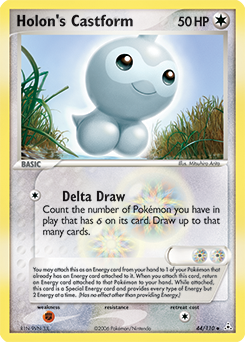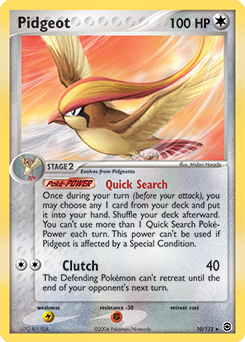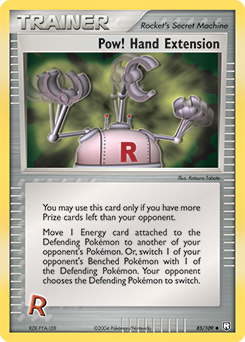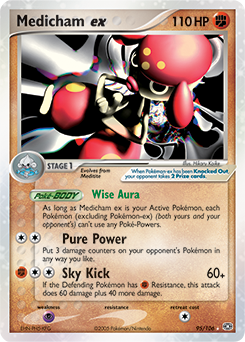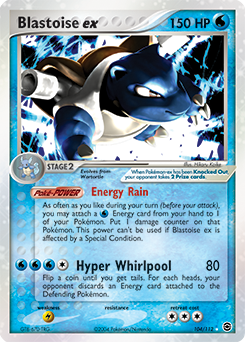This month, our Pokémon TCG luminaries look back on the EX
Series, an era near and dear to many of them. It’s easy to see why: decks
featured fascinating Pokémon and engines, and matches required plenty of
tactical prowess. Powerful Pokémon-EX came together with crafty Holon
Pokémon and much more, creating exciting battles that are still discussed
today.
Check out what our contributors have to say about their
favorite cards from this era, and be sure to check out previous entries from
the Sword
& Shield, Sun
& Moon, XY,
Black
& White, and Diamond
& Pearl eras. Then, check back next month as our 25th celebration
sets its sights on Johto.
Tord Reklev
Three-Time International Champion
In the Delta Species and Holon Phantoms expansions
from the EX Series, we found several Pokémon with a unique attribute:
Holon’s Pokémon could be attached to other Pokémon as Energy cards from your
hand, instead of being played normally. Holon’s Castform could be attached to a Pokémon as a Special
Energy to provide two Energy of any types. The drawback to balance this effect
out was having to return to your hand an Energy that was already attached to
the Pokémon.
Still, this effect was extremely versatile and allowed
certain Pokémon with an otherwise unreasonable Energy cost to work, such as Lugia-EX. Having Energy
cards disguised as Pokémon let players have a ton of fun with deck building,
since the cards that could search and retrieve the attackers could also search
out the Energy. Holon’s Castform is undoubtedly the strongest Holon’s Pokémon
with its Delta Draw attack; it served as a great opener for any deck that
revolved around Delta Species Pokémon.
Being able to search out Supporter cards from the deck is
great on its own, but what pushed Holon Transceiver
over the top was being able to retrieve Supporter cards from the discard
pile as well. To fully grasp how powerful the Holon Transceiver was, it’s
important to remember how powerful the Supporters were that Holon Transceiver
could search for.
The most impactful Supporter it could fetch was Holon Mentor, which allowed the
player to search out three Basic Pokémon with 100 HP or less and put them into
their hand. This was a great opener for most decks to establish a strong field
early on. Later in the game, Holon Transceiver could be used to pick up Holon Scientist or Holon Adventurer to draw cards. Holon Researcher was excellent for
searching out Delta Species Pokémon. Holon Farmer
could restore a bunch of resources, while Holon Lass was able to find Energy cards.
Holon Transceiver paired with some, if not all, of these Supporters,
creating what was often referred to as the Holon engine. This engine is
somewhat similar to the combination of the Tag Call Item card and the TAG TEAM
Supporter cards we currently have in the Standard format, but the Holon engine
was blessed with more powerful Supporter cards, especially for its time. However,
the Holon engine did not have to compete with the incredible options we have
today in Professor’s Research,
Marnie, or Boss’s Orders.
Jason Klaczynski
Three-Time Pokémon TCG World Champion
The ability to choose any card from your deck to bring into
your hand each turn gives you an overwhelming advantage. That’s why most Stage
2 decks in 2005 took advantage of Pidgeot‘s
Quick Search Poké-Power, with players almost always pairing their Pidgey and Pidgeot with four Rare Candy to give the best chance
at getting it into play quickly.
Once Pidgeot was in play, things easily fell into place.
Need to evolve your other Pokémon? No problem; Pidgeot would find the missing
pieces you needed to evolve. Looking for the perfect Supporter for the turn?
Pidgeot brought it into your hand! Whenever you had a game where one player was
Quick Searching and the other wasn’t, you rarely saw the player without Quick
Search emerge victorious.
Pidgeot wasn’t left unchecked very long, though! Only two expansions
after its debut in EX FireRed LeafGreen, it met two hard counters: Medicham-EX and Battle Frontier. At that point,
decks split down two paths: they either played Pidgeot or they opted to counter
it. Medicham-EX was able to shut down Pidgeot decks and claim both the
Junior and Senior Divisions at the 2005 World Championships, but Masters
Division player Jeremy Maron proved how powerful Pidgeot still was with his first-place
Nidoqueen/Pidgeot “Queendom” deck. Pidgeot continued to see play and success until its
rotation at the end of the following season.
There was no period of the game that punished you more for
taking a Prize lead than the EX era. Between Scramble Energy and Pow! Hand Extension, players who came out swinging often
immediately regretted their decision as their quick Prize-taking attacks were
met by an even stronger Scramble Energy-fueled counterattack.
Before Scramble Energy existed, slower, Evolution-based
decks often succumbed to speedy, aggressive decks that would overwhelm them
before they could set up. But with Scramble Energy, these slower decks could
now mount massive comebacks, unleashing powerful attacks with this single
Energy card.
Scramble Energy’s three Energy for an evolved Pokémon was
such an advantage that players designed decks entirely focused on activating
it. One such deck used Electrode-EX‘s
Extra Energy Bomb to surrender two Prize cards, enabling massive Big
Eggsplosion attacks from Exeggutor.
Another, a Raichu δ/Exeggutor δ “Rai-Eggs”
deck, used attacks that spread damage (rather than take immediate Prize cards)
so it could harness Scramble Energy’s full power after surrendering a KO.
Such interactions, where players can be punished for taking
Prize cards, make for deeply strategic (and even perplexing) games. It’s also
part of the reason cards from the EX era were—and still are!—so fun to
play with.
Ross Cawthon
17 World Championships Appearances, Two-Time Worlds Runner-Up
The “Holon” cards were themed around a Pokémon science
community. They included powerful Trainers connected to Holon Transceiver, as
well as Delta Species Pokémon that were each a different type than their usual
(e.g., Gardevoir-EX).
The most interesting were the Holon’s Pokémon, which all shared the same
characteristic: Pokémon that could be played as Energy. In the Pokémon TCG,
cards that search for Pokémon (such as Celio’s Network) are commonly played. With one or two Holon’s
Pokémon in your deck, you would effectively increase your Energy card count by
several more cards, since all your Pokémon-search cards would be Energy-search
cards as well.
Holon’s Electrode
(as well as Holon’s Magneton
and Holon’s Castform)
had a particularly cool effect. They would provide two Energy of any types,
with the cost of returning to hand one Energy card already attached to a
Pokémon. The most effective combination with these cards was Blastoise-EX, whose Energy
Rain Poké-Power allowed you to attach any number of Water Energy in a turn.
With a Water Energy or two, and a Holon’s Electrode, you could power up most
attacks in the game instantly. Some of the popular attacking options were Steelix-EX and Lugia-EX. This combination
of cards would create a rainstorm that few decks could compete with!
The EX Series introduced what is now a familiar
concept in the Pokémon TCG: cards that became more powerful when a player has
more Prize cards remaining. The most powerful cards of this type in the EX
Series were Scramble Energy and
Pow! Hand Extension. “Pow!”
allowed you to choose one of two very powerful effects: switch in an opponent’s
Pokémon from the Bench, or move an Energy from an opponent’s Active Pokémon to
the Bench. The only cost of Pow! is that you need to have more Prize cards
remaining than your opponent.
The utility of Pow! is incredible. If you need to Knock Out
any opponent’s Pokémon, you can switch it in. If you want to trap an
inconvenient Pokémon with a high Retreat Cost in the Active Spot, switch it in.
If they attach Energy to that Pokémon to try to eventually retreat, move that Energy
to the Bench. My 2005 Worlds Finalist deck used all these possibilities of Pow!:
Dark Tyranitar could either
do big damage for KOs with Grind and Bite Off, or use Spinning Tail to damage all
the opponent’s Pokémon, the latter strategy being effective when I could trap
non-attacking Pokémon in the Active Spot. To power these attacks, and activate
my Pow! Hand Extensions, I used Electrode-EX‘s
Extra Energy Bomb Poké-Power.
Michael Pramawat
Europe International Champion, Worlds Runner-Up
Medicham-EX
is one of my favorite cards of all time. It might be the foundation of the
first iteration of a control deck in the Pokémon TCG that I recall. The main
strategy with this card was to have it in the Active Spot and turn off your
opponent’s Poké-Powers with its Wise Aura Poké-Body. Then you would accumulate
damage onto the opponent’s field with Pure Power to set up future Knock Outs.
By letting the first Medicham-EX get Knocked Out, you
could go behind on Prizes and gain access to Pow! Hand Extension. The
combination of this card and Medicham-EX gave a great amount of control
over the game. The deck also played Rocket’s Admin,
which is functionally the same card as N:
it would limit your opponent’s options to prevent them from finishing the game.
Medicham-EX‘s second attack, Sky Kick, could finish
out the game. While spending most of the game using Pure Power to set up Knock
Outs, Sky Kick will actually take them. It also has the bonus effect of doing
more damage against a Pokémon that has Fighting Resistance. This card really
opened up the strategic world of the Pokémon TCG and holds a warm place in my
heart.
Blastoise decks have been some of the most fun decks to play
since the debut of the Pokémon TCG. Base Set Blastoise is iconic because
of its Rain Dance Pokémon Power, which breaks the one-Energy-per-turn rule. Blastoise-EX is the
successor of this card with its Energy Rain Poké-Power, which was combined with
Lugia-EX to do a
massive 200 damage. It was also paired with Steelix-EX
to be able to snipe the Bench. This deck was able to do both devastating
damage and control the opponent’s Bench.
One of the more humorous aspects about Blastoise-EX decks
was that it ran single copies of almost 20 cards. This was the toolbox deck of
the format that could do anything it wanted. Thanks to Holon’s Castform and Holon’s Magneton, it got to reuse Water
Energy to attack with any Pokémon. And above all, the real reason a deck like
this could even function is because of Pidgeot‘s
Quick Search Poké-Power. This is definitely one of the most fun decks to
play, and Blastoise continues to be one of the strongest Pokémon in general. If
I have to choose between Bulbasaur, Charmander, or Squirtle, I know which one
I’m going with.
Mike Martin
20-year Pokémon TCG Professor
You might be wondering why I’m writing about Marill, a common card that was not
used in any significant tournament-worthy deck at the time. It’s a cute enough
card, being illustrated by my favorite Pokémon artist, Mitsuhiro Arita. I
actually got to play a Pokémon TCG game against Mr. Arita at the 2004 World
Championships, although he did have a card designer from Creatures Inc. helping
him since he hadn’t played the game before. But that’s not why I chose it.
This Marill has a unique place among Pokémon TCG card
rulings. You see, when it was released in Sandstorm booster packs, there
were two versions of the card printed. One version, the correct one, had a
Retreat Cost of 1. The other version, however, was printed with a free Retreat
Cost!
It was noted immediately that the original Japanese version
of the card had a Retreat Cost of 1, so players were immediately clamoring for
a ruling on how to play this card properly. There was a massive Rule Team
discussion among judges, as well as Pokémon USA (as The Pokémon Company
International was known at the time), on how to handle this. At the time, they
wanted to maintain continuity with how previous rulings had been handled.
Previously, anytime a card’s game text was misprinted, as long as it wasn’t
completely game-breaking, it was ruled to “play as printed.”
And so, that is how this was ruled. If you had the free-retreat
version, you got to retreat for free! But this was the last time that a card’s
misprinted text was ruled this way. Now, if a card text or statistic does not
match the original Japanese card, either a ruling or errata is issued stating
what the card’s text should be and how it should be played.
The Team Magma vs Team Aqua expansion was a bit of an
oddity at the time. Except for some cards that had originally been Japanese
promos, almost all of the cards in the set were specific to one of the two
competing teams. Additionally, the set introduced the concept of dual-type
Pokémon. But for whatever reason, players dismissed the Team Pokémon in this
set for tournament play. Double Rainbow Energy
and a few of the non-Team Pokémon-EX were the only new cards that
players were using at all.
Now, when Pokémon USA took over Organized Play in 2003,
there wasn’t enough time to arrange for a World Championships that year. But
they did hold qualifiers during late 2003 and early 2004 for players to earn
invitations to their first World Championships in 2004. The competitors honed
their decks all through the year, fine-tuning their deck lists with new
releases or making changes to counter the developing metagame. But Team Magma
or Team Aqua were not seen so often at the top tables.
That is, until players arrived at the 2004 World
Championships. Many of the Japanese invitees had been working in a totally
different metagame and, led by Tsuguyoshi Yamato, realized that in fact a Team
Magma deck, featuring Team Magma’s Groudon,
was the best deck in the format. The deck they constructed had amazing synergy
and speed. Team Magma’s Groudon was the main attacker, but support cards could
retrieve Energy from the discard pile and move it around as needed. This
allowed it to mount an attack without having to spend any time building up an
attacker on the Bench. The deck and its players (including Yamato) took the
rest of the world by surprise and swept the World Championships, winning in all
three age divisions.
The Pokémon TCG community would not be the same without these five contributors to the game, and we appreciate their valuable insights. Be sure to check back throughout the year to see more of their reflections on their favorite cards from the long history of the Pokémon TCG.
About the Contributors

Tord Reklev
Tord Reklev is a contributing writer for Pokemon.com. He is a longtime player from Norway, playing the game since he was 6 years old. He is notable for being the only Masters Division player to win the North America, Europe, and Oceania Internationals, and he recently made Top 4 at the World Championships. Outside of the game, he is a student and enjoys playing tennis. You can find him at most big events, and can follow him on Twitter at @TordReklev.

Jason Klaczynski
Jason Klaczynski is a three-time Masters Division World Champion (2006, 2008, 2013) and the 2015 US National Champion. Jason began playing the Pokémon TCG during the initial Pokémon craze of 1999 and played competitively from that point through 2017. Since then, Jason has focused on re-exploring and writing about the game’s earliest formats, which he regularly plays with friends.

Ross Cawthon
Ross Cawthon is a longtime player, starting to play tournaments in 2000. He is the only player to compete in all 17 Pokémon TCG World Championships, finishing as a finalist in 2005 and 2011, and a semi-finalist in 2016. He is known for creating many new “rogue” decks over the years. Ross has a Ph.D. in astrophysics and studies dark energy (not to be confused with Darkness Energy cards).

Michael Pramawat
Michael Pramawat is a seven-time Regional Champion and International Champion. He has competed at the highest level and was almost World Champion, finishing second in 2010. Michael is a master of the Pokémon TCG and continues to play with the goal of being the very best, like no one ever was. You can follow him on twitter at @michaelpramawat.

Michael Martin
Michael Martin, AKA “PokePop,” hasn’t won a single tournament. He has been judging and running Pokémon TCG events since 2000 and has been invited to judge at every single Pokémon World Championships. He also helps maintain the Pokémon TCG Compendium, where all official game rulings for Organized Play are collected. ‘Pop misses seeing all the players and other Professors in person and can’t wait for live events to resume.

Source: Pokemon


